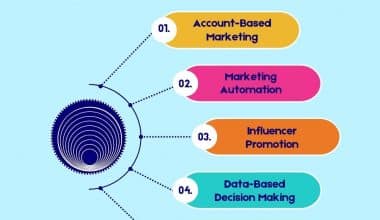Just like in football games, the success of a business rarely depends on individual efforts. Here’s why: the workplace is a dynamic environment, and to succeed there, businesses and employees alike need to cultivate workplace teamwork. Building workplace teamwork is not just gathering a group of people and adding them to teams; it requires clear goals and objectives, open but effective communication, strong leadership, and perseverance.
So, how can you build workplace teamwork? How can your company maximize team power? This thorough guide provides insights, practical ideas, and professional suggestions to help you maximize your team’s potential and succeed.
What’s Teamwork?
“The best teamwork comes from men who are working independently toward one goal in unison.” – James Cash Penney. Therefore, teamwork is more of a group effort toward achieving a goal. It further requires combining diverse abilities, viewpoints, and experiences to reach these goals. Teamwork is about using team members’ strengths to achieve more than they could alone.
Like in the relay, athletes need each other to win, despite individual skills. The same is true for the workplace. Working with colleagues with different strengths can help you achieve more. Teams commonly work on specific projects or deliverables in project-based organizations. For instance, marketing, product development, and customer service may work together to launch a new product.
Why Workplace Teamwork Matters
I have come to understand that working as a team is more productive and innovative. The Harvard Business Review report further supports this by finding that diverse teams boost market share by 45%.
In addition, a recent Gartner study shows that high-performing teams solve problems 86% better and surpass business goals 50% more often than low-performing teams. This was evident in my own experience when I worked with high-performing teams. Everyone felt free to share ideas in our collaborative problem-solving method. This further reduced our essential project development time by 30% compared to siloed projects. It also showed me how teamwork can boost innovation and efficiency.
Benefits of Teamwork in the Workplace
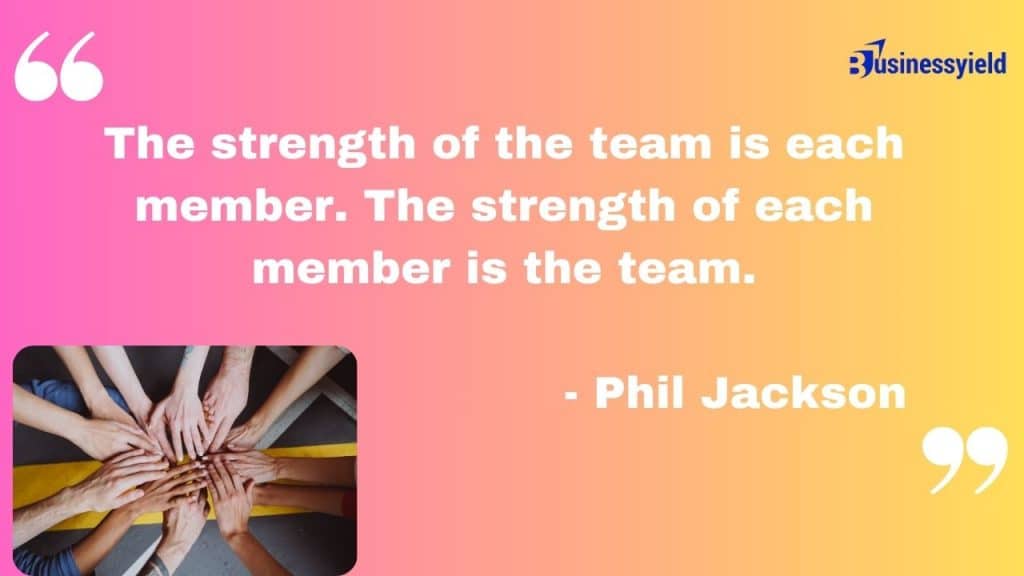
The benefits of teamwork in the workplace far outweigh its challenges. Below are some reasons why teamwork in the workplace is essential for organizational success:
- Efficiency and Productivity: A benefit is that teamwork in the workplace allows everyone to complete tasks using a variety of skills and abilities, therefore promoting “two heads are better than one.”
- Better Innovation and Creativity: Open communication and brainstorming in diverse teams encourage creative problem-solving and also help to discover ways of doing things.
- Increased Trust and Harmony: Working toward common goals builds trust and a friendly work environment. In addition, teamwork fosters trust, open communication, and a shared purpose, strengthening the company culture.
- Employee Morale and Engagement: This is another great benefit of teamwork in the workplace. Being part of a supportive and collaborative team can make employees happier and more productive. Gallup reports 23% higher profits for engaged teams.
Examples of Teamwork in the Workplace
There are numerous examples where teamwork has brought about overall success for organizations. These examples cut across various industries and sectors. The following are some real-life examples of teamwork in the workplace:
#1. The Mars Curiosity Rover Mission
The “Mars Curiosity Rover” mission is a great example of teamwork in the workplace. To ensure the success of the MARS “Curiosity” rover mission, NASA and all the foreign space agency scientists, engineers, and mission controllers worked together. To land and explore Mars, they worked across continents and fields to design, manufacture, launch, and operate the rover.
#2. The Success of the Amazon Delivery Network
We can also find another example of teamwork in the workplace with the Amazon Delivery Network. In logistics management, I discovered how teamwork makes complex delivery networks like Amazon successful. Warehouse workers, delivery drivers, logistics planners, and technology experts work together daily to deliver millions of shipments on schedule. This shows that each team member is vital to the delivery network’s efficiency and reliability.
#3. Vaccine Development for COVID-19
During the COVID-19 pandemic, we saw the fast development of life-saving COVID-19 drugs. This highlights the strength of global teamwork. Scientists from different countries, pharmaceutical companies, and research institutions share important information, knowledge, and resources. Therefore, speeding up the creation and spread of these vaccines saved a huge number of lives.
#4. Open-Source Software Development
Millions of workers worldwide work together on many software projects, like Linux and Wikipedia. They help make these free and open-source tools better by contributing code, fixing bugs, and working together. This further shows how powerful the spread of teamwork can be.
#5. Building the International Space Station (ISS)
15 countries and five space organizations collaborated on this engineering feat. Despite cultural and language obstacles, engineers, astronauts, and other members designed, assembled, and maintained the ISS, demonstrating the potential of international teamwork to achieve seemingly impossible achievements.
Quotes to Inspire Teamwork in The Workplace
During a busy workday, a little inspiration can also boost team spirit. Some timeless quotes that businesses and leaders can use to inspire teamwork in the workplace include:
#1. “Great Things in Business are never done by One Person. They’re done by a Team of People.” – Steve Jobs

#2. “Individual Commitment to a group effort – that is what makes a Team Work, a Company Work, a Society Work, a Civilization Work.” – Vince Lombardi

#3. “Teamwork Makes the Dream Work.” – John C. Maxwell
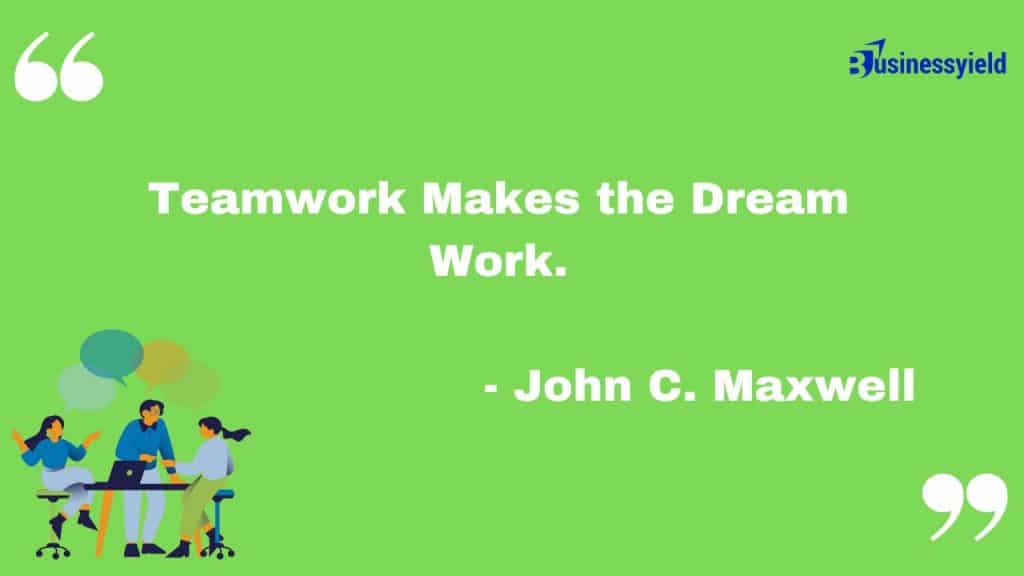
#4. Unity is strength… when there is teamwork and collaboration, wonderful things can be achieved.” – Mattie Stepanek
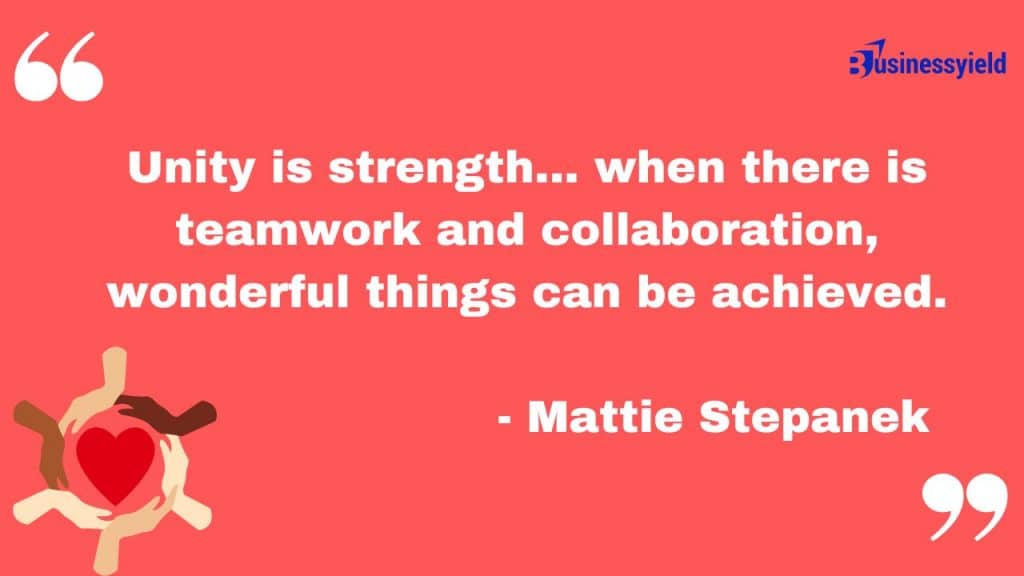
#5. “Individually, we are one drop. Together, we are an ocean.” – Ryunosuke Satoro
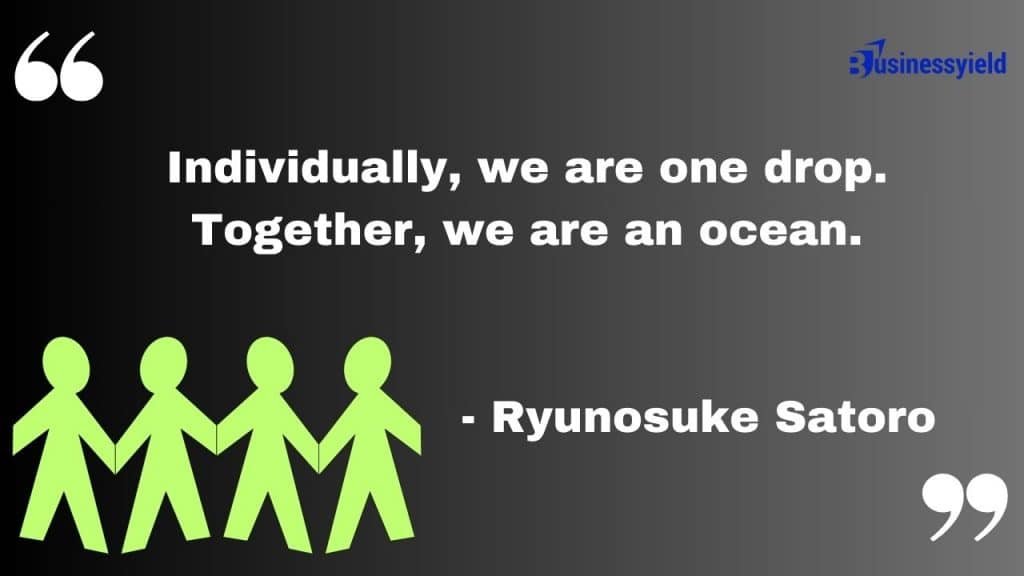
#6. “Talent wins games, but teamwork and intelligence win championships.” – Michael Jordan (Basketball Legend)
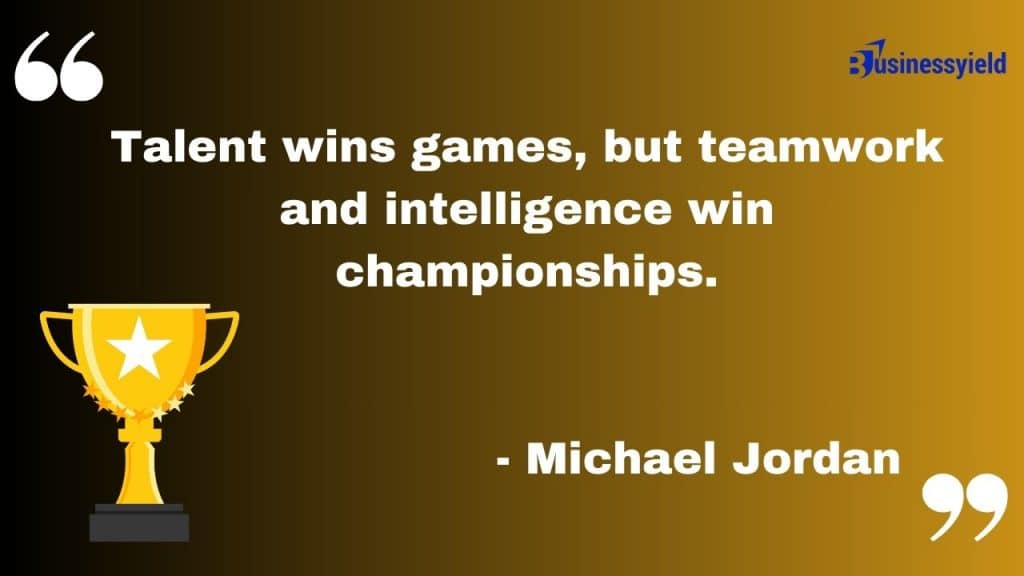
#7. “If everyone is moving forward together, then success takes care of itself.” – Henry Ford (Founder, Ford Motor Company)
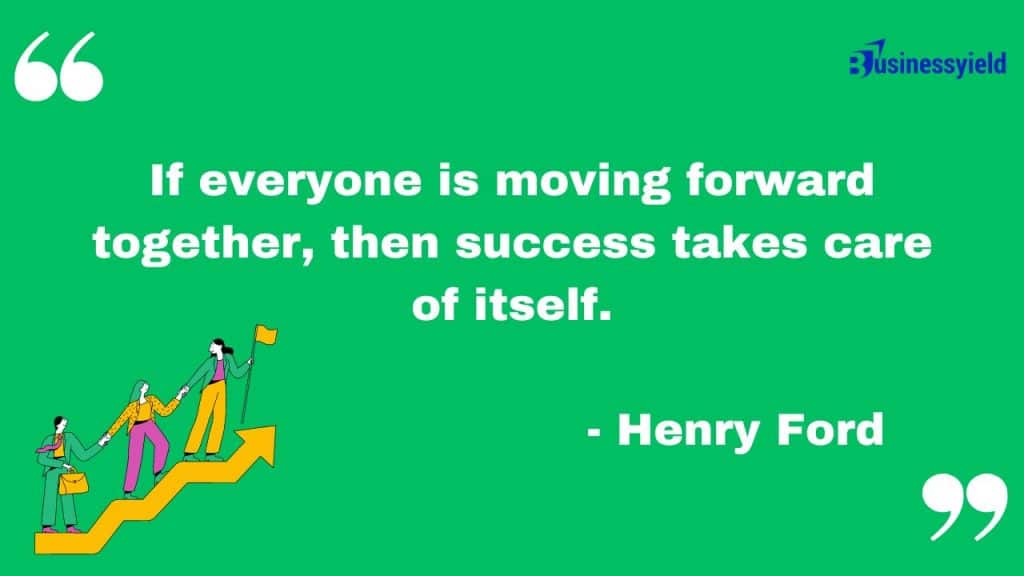
#8. “It is amazing what you can accomplish if you do not care who gets the credit.” – Harry S. Truman (33rd President of the United States)
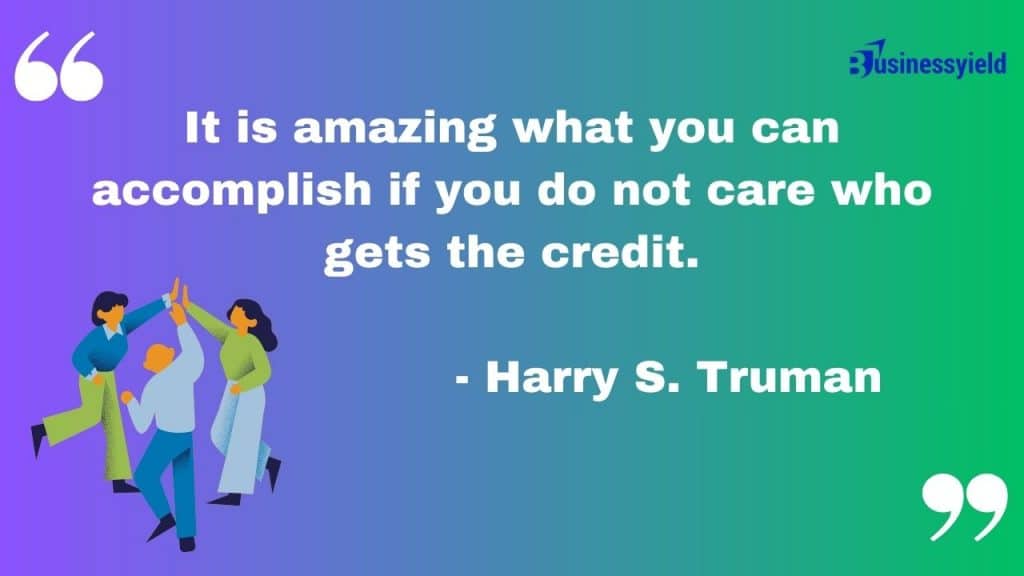

#10. “There is no ‘I’ in a team, but there is in the win.” – Mia Hamm (Soccer Player)
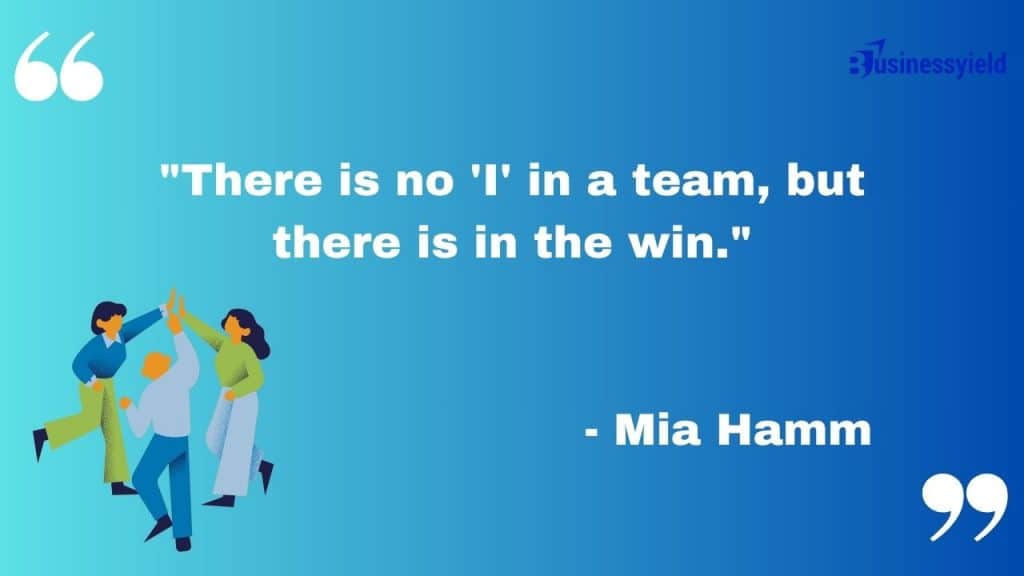
How to Build the Foundation for Effective Teamwork in the Workplace
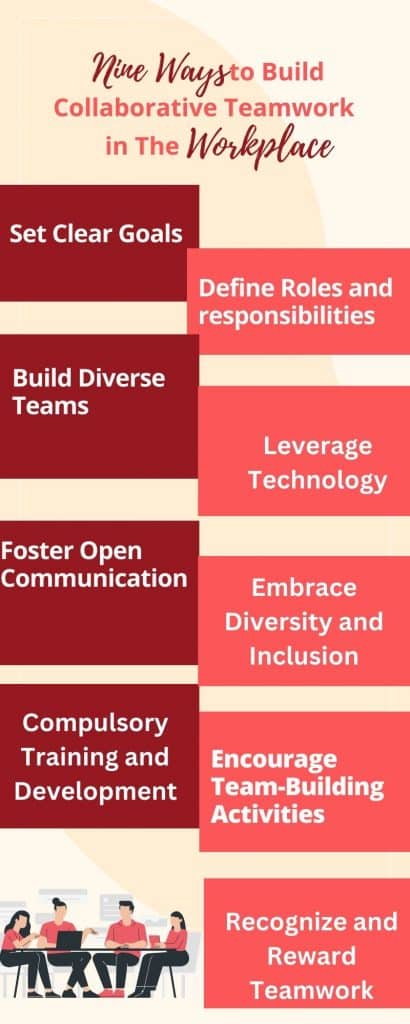
The following are some ways you can build and improve teamwork in the workplace. Feel free to download the adaptable checklist below for a more tailored approach
#1. Start with Clear Goals and Objectives
Set clear, quantifiable goals for your team. This defines tasks and gives everyone a sense of direction. I recommend setting goals using the SMART framework (Specific, Measurable, Achievable, Relevant, and Time-bound).
#2. Build Complementary and Diverse Teams
Diversity is a critical component of team formation in the workplace. You have to put people with different experiences, backgrounds, and abilities together, because this will allow you to build a complex web of viewpoints that stimulates creativity and produces stronger solutions to business problems and needs.
In my workplace, we intentionally hire people with various skills—social media, content production, and analytics backgrounds. This has further empowered us to approach marketing initiatives from multiple angles, creating a more comprehensive and effective plan. Combining social media experience with data research has helped us find target groups and create content they like.
#3. Clarify Individual Roles and Duties
Once you put the team together, it is critical to clearly define the roles and duties of each member. I found this to be helpful, as my team members have an idea of their specific roles and responsibilities. This, therefore, promotes clearer communication and workflow by reducing confusion, guaranteeing accountability, and avoiding effort duplication.
#4. Foster Open Communication
The single biggest problem in communication is the illusion that it has taken place.” – George Bernard Shaw. Successful teams rely on good communication. Good communication helps team members communicate, identify needs, collaborate on tasks, and handle issues productively.
Furthermore, you can promote active listening. Active listening helps teams build trust and understanding, in my experience. I have worked with a skilled teammate who struggles to communicate. But when we created a safe space for them to share by actively listening to both verbal and non-verbal cues, our team benefited greatly from their views and contributions
#5. Establish Rules and Expectations
Clear guidelines and expectations help everyone understand how the team will work. So, I previously worked on a cross-functional project with coworkers from different time zones, and miscommunication and missed deadlines were common. To fix this, we set explicit communication protocols, including preferred channels, meeting times, and task deadlines. This greatly enhanced our workflow, promoting accountability and shared responsibility.
#6. Leverage Technology
Technology has now become a vital tool for boosting communication and facilitating teamwork. During the COVID pandemic, our team struggled with teamwork and information sharing after switching to remote work. However, Slack and Google Meet proved invaluable. Furthermore, we built clear communication protocols on these platforms to facilitate information flow, real-time discussions, and task tracking. Even when working remotely, this has encouraged connection and productivity.”
As a business leader, you should also invest in training and support. Don’t expect your workforce to master technology immediately. Training and support also guarantee that everyone is comfortable using the tools and can maximize their potential.
#7. Compulsory Training and Development
A leader should give their staff the abilities and information they require to succeed in their positions. To improve teamwork abilities in the workplace and promote lifelong learning, offer options for continual training and development, such as seminars, workshops, and online courses. At my workplace, mandatory skill acquisition training has been introduced for all employees. Consequently, we’ve witnessed a notable enhancement in productivity, as our proficiency with various technologies continues to grow with each passing day.
#8. Embrace Diversity and Inclusion
I once worked in a team with diverse individuals of varying cultures. We were able to respect cultural differences in meetings, empower everyone to contribute, and actively seek varied opinions while discussing business solutions. This strategy further promoted a healthy and courteous workplace, greater idea development, and a better outcome.”
#9. Encourage Team-Building Activities
Team-building exercises are entertaining and foster cooperation, trust, and connections. To unite your company, invest in ropes courses, scavenger hunts, and other activities that can build teamwork in the workplace.
I saw teamwork transform my workplace. We used team-building events to boost morale. During our team-building exercises, we played chess, scrabbled, and even went on to enjoy other fun outdoor activities. In essence, team spirit returned, creating a more cheerful and productive workplace.
#10. Recognize and Reward Teamwork
Recognition and gratitude inspire. Team members are more engaged, productive, and devoted to goals when they feel appreciated.
Appreciation goes beyond the best performers. In my experience, team members’ behind-the-scenes contributions are also vital. A teammate went above and beyond to help me with personal issues. Recognizing their goodness in public further encouraged teamwork in the workplace and motivated others to help.
Challenges in Implementing Teamwork in the Workplace
Working together as a team is not always smooth, even though it has many benefits. Here are some common problems that groups may face, ranging from problems with communication to personality clashes:
#1. Resistance to Change
I’ve faced such resistance to change on more than one occasion. While switching to a team-based approach, some team members were worried about losing autonomy. My team discussed the benefits of collaboration and gave examples of how teamwork could improve performance and contentment. Open communication and clear goals eased anxieties and facilitated an easier transition.
#2. Communication Barriers
A common hindrance to teamwork in the workplace is ineffective communication. This can be challenging in a globalized world when teams are typically distributed across multiple regions and time zones. Businesses can use technology, detailed protocols, active listening, and empathy to overcome communication barriers.
#3. Conflicts
In workplace teamwork, diversity is a strength, but it can also lead to conflicts. As a business leader, you should train your staff in conflict resolution and set up courteous dispute resolution practices.
#4. Balancing Individual vs. Collective Aims
Sometimes team members’ objectives may clash with those of the organization. Leaders must ensure that everyone knows their part and responsibility so that no confusion or unnecessary work is done twice. Also, make sure everyone knows what the general goals are and how they can help reach them. You can also allow members to add their unique abilities and perspectives to promote alignment.
How to Turn Teamwork Problems into Opportunities in the Workplace
#1. Leadership
The most important thing you can do to promote and maintain a mindset of teamwork is strong leadership. I believe leaders must model the values they expect from their teams. In a tight project schedule, my boss was ready to answer inquiries, provide help, and address issues. This hands-on approach helped complete the project on time and generally fostered team trust, drive, and accountability.
In essence, my team developed a strong sense of teamwork by seeing our leader constantly show empathy, active listening, and collaborative decision-making. This leadership approach encouraged open communication and team participation, resulting in project success.
#2. Continuous Improvement
It is your job as a leader to promote continuous improvement, encourage teams to reflect on procedures, find areas for improvement, and implement solutions iteratively. So, try new things and learn from your mistakes.
#3. Empowerment and Autonomy
As a leader, give your team power by delegating tasks and authority, letting them make their own decisions, and encouraging them to take responsibility for projects and efforts. Let the people on your team take the lead, and back them up in their work.
#4. Cultural Alignment
Furthermore, make sure that the way your organization works is in line with the ideas of teamwork and collaboration by creating a trusting, respectful, and welcoming space for everyone. Honor everyone’s differences, thank them for their accomplishments, and help the team feel like they have a common goal.
#5. Regular Feedback and Evaluation
Give your team regular feedback, evaluations, and “heart checks” to keep an eye on their progress, find places where they can improve, and celebrate their wins. Promote an open feedback culture where helpful advice is valued and taken into account.
The Role of Leadership in Fostering Effective Teamwork in the Workplace
Leadership is encouraging and allowing individuals to attain their best potential, not merely telling them what to do. Leaders may improve teamwork in the workplace by doing the following:
- Set a good example. Show your team what kind of change you want to see. Show them ways to work together, like active listening, understanding, and taking responsibility, and create an environment where people respect each other and work together.
- Give your employees vision and direction. Make a compelling picture of the future and set clear goals and standards for your team to follow. I still remember the day my boss outlined the vision of the business, and its future growth plan, and suddenly, I felt like I knew my part. Also, give your team a sense of direction and purpose, and bring them together around common goals.
- Support and Resources: As a leader, you can also help your team succeed by giving them the tools and help they need. Get rid of barriers, speak up for their needs, and spend money on technologies and tools that make working together and talking to each other easier.
- Encourage learning and growth: Put money into leadership development programs, coaching, and mentorship programs to give you and your team the skills and attitude you need to do well in a team-based workplace. Show your team that you are committed to learning throughout your life, and push them to do the same.
Why is Teamwork Important in the Workplace?
Teamwork offers many benefits in the workplace, from boosting creativity and productivity to creating a positive work environment and improving employee morale and engagement. It also reduces employee churn and brings about the overall success of a business.
How do you Define Teamwork in the Workplace?
Teamwork is a collaborative effort of individuals and stakeholders in a business enterprise. it involves pooling together diverse skills and resources and working towards a particular goal to bring about the overall success of the business.
How do you Show Teamwork at Work?
You can show teamwork in the workplace by actively listening, respecting diverse opinions, communicating openly, sharing responsibilities, celebrating wins together, etc.
The Power of “We”
As a leader, you can unlock your team’s power, achieve outstanding results, and make your workplace happier using teamwork and the tips above. Teamwork is about collaboration, trust, and creating a safe space where everyone feels valued and empowered to contribute their unique gifts, not just meeting goals. Remember that “we” is stronger than its parts. Build strong teams and achieve amazing things!
- COLLABORATION SKILLS: Definition, Examples, and Ways to Improve Them
- HUMAN RELATIONS: Meaning, Theory, Workplace, Commission & Importance.
- LIST OF CORE VALUES: Core Value Examples for Bu
- LEADERSHIP QUOTES: 35 Inspiring Quotes of All Time
- TEAMWORK: What It Means & Why It Matters in the Workplace



